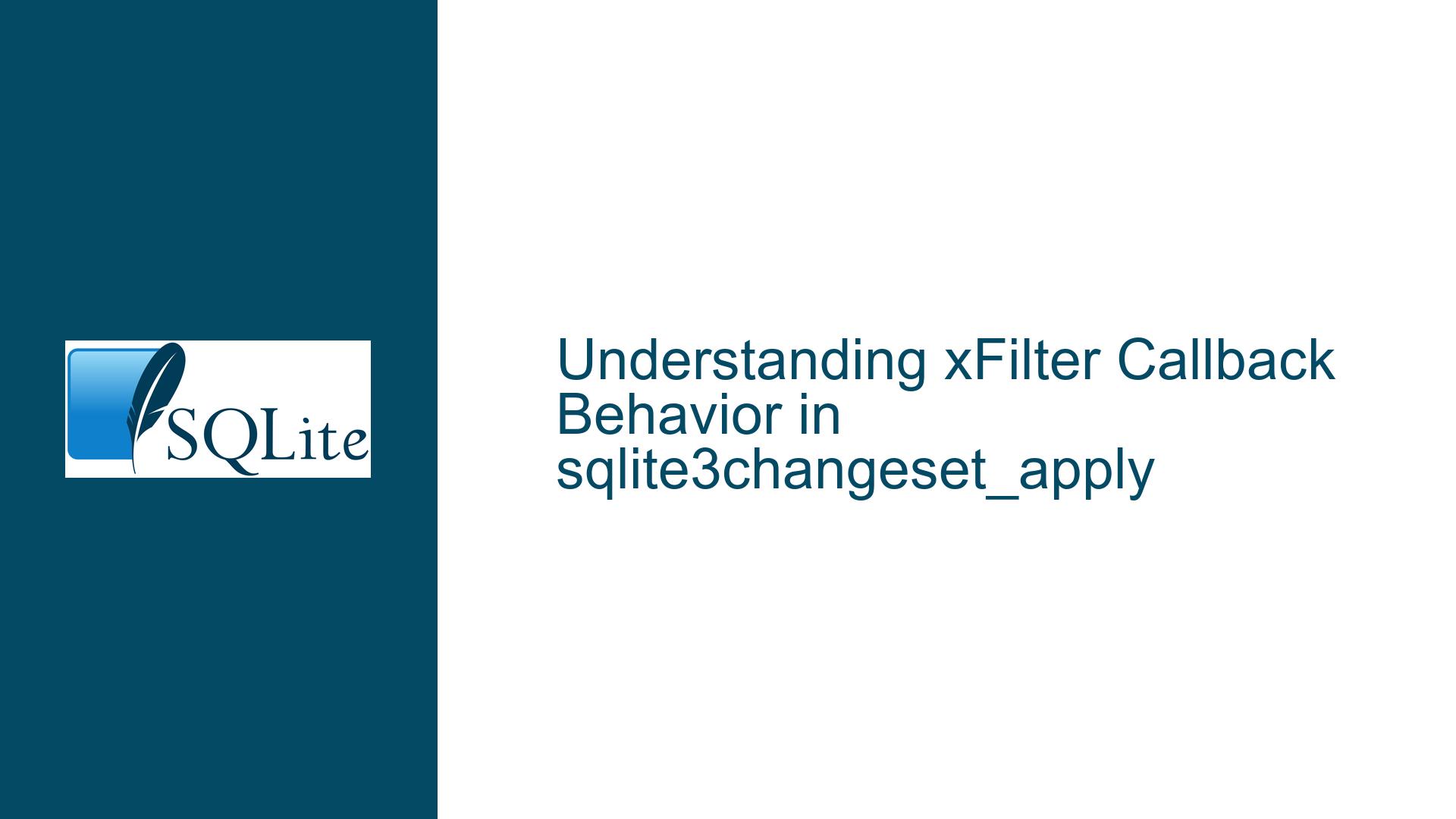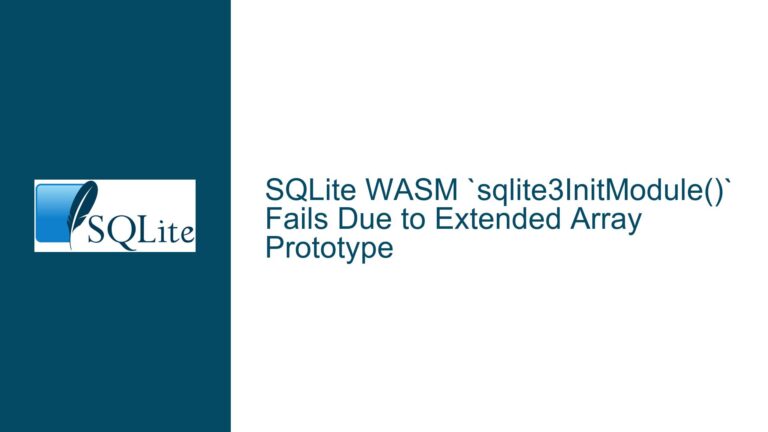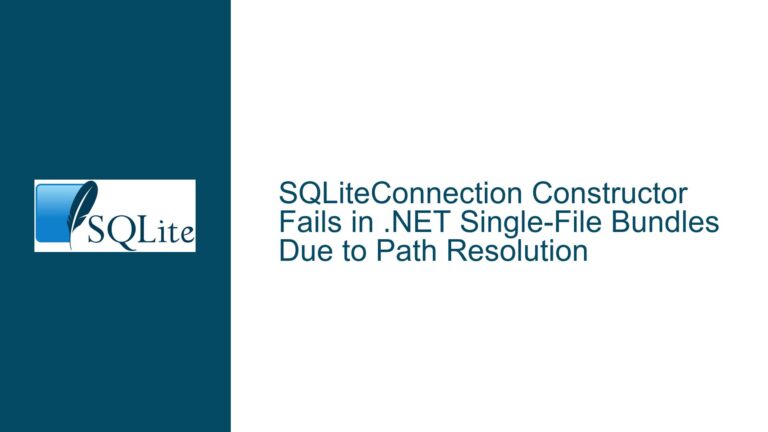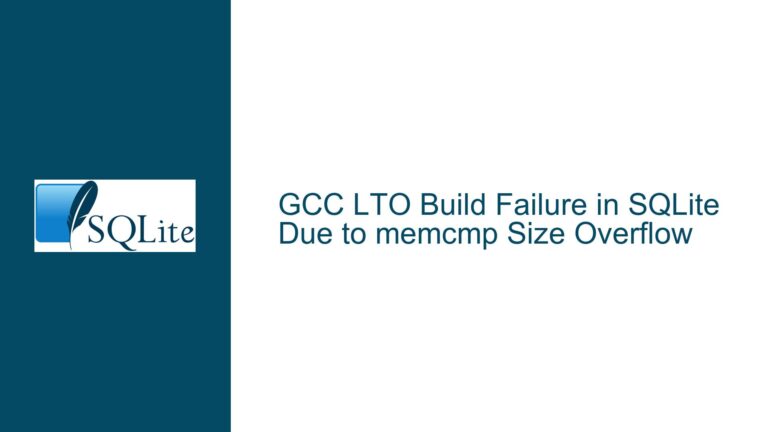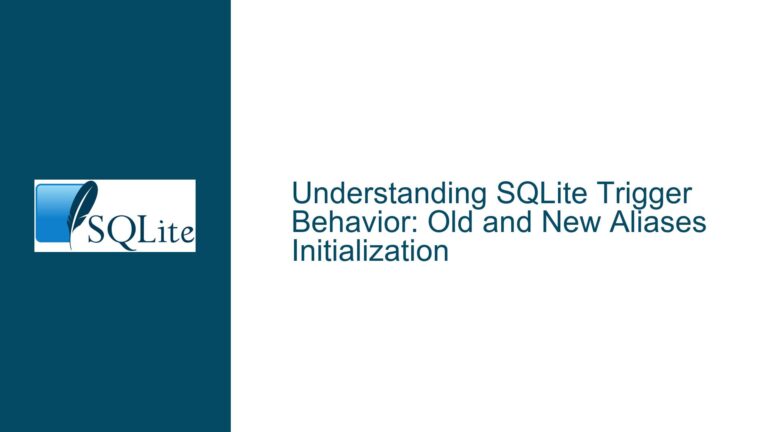xFilter Callback Behavior in sqlite3changeset_apply
Issue Overview: xFilter Callback Invocation During Changeset Application
The core issue revolves around the behavior of the xFilter callback when applying changesets using the sqlite3changeset_apply function in SQLite. Specifically, the concern is whether the xFilter callback is invoked once for every table in the changeset or only during the application of changes. This distinction is critical for developers who need to abort the changeset application process if the xFilter callback throws an error.
The xFilter callback is a user-defined function that allows filtering of changesets before they are applied. It is part of the SQLite Session Extension, which provides mechanisms for tracking and applying changes to databases. The callback is designed to give developers control over which changes are applied, enabling scenarios such as partial replication, conflict resolution, or conditional application of changes.
The confusion arises from the timing of the xFilter callback invocation. If the callback is called once for every table in the changeset, developers can implement logic to abort the entire changeset application if any invocation fails. However, if the callback is called during the application of changes, aborting the process becomes more complex, as the changeset application may already be partially completed.
This issue is particularly relevant in scenarios where changesets are large or contain changes to multiple tables. In such cases, ensuring that the changeset application can be cleanly aborted without leaving the database in an inconsistent state is crucial. The ability to abort the process based on the xFilter callback’s behavior is essential for maintaining data integrity and implementing robust error handling mechanisms.
Possible Causes: Misunderstanding of xFilter Callback Invocation Timing
The primary cause of this issue is a potential misunderstanding of how the xFilter callback is invoked during the changeset application process. The SQLite documentation does not explicitly state whether the callback is called once per table or during the application of changes. This ambiguity can lead to incorrect assumptions about the callback’s behavior and its implications for error handling.
One possible cause is the assumption that the xFilter callback is invoked once for every table in the changeset. This assumption might stem from the callback’s role in filtering changes, which could logically be applied at the table level. If this were the case, developers could implement logic to abort the changeset application if any table’s changes fail the filter criteria.
Another possible cause is the assumption that the xFilter callback is invoked during the application of changes. This assumption might arise from the callback’s integration with the changeset application process, where it is used to determine whether specific changes should be applied. If the callback is invoked during the application of changes, aborting the process becomes more challenging, as some changes may have already been applied.
Additionally, the lack of explicit examples or detailed documentation on the xFilter callback’s invocation timing contributes to the confusion. Developers often rely on documentation and examples to understand how to use APIs effectively. In this case, the absence of clear guidance on the callback’s behavior can lead to incorrect implementations and potential issues in production environments.
Troubleshooting Steps, Solutions & Fixes: Clarifying xFilter Callback Behavior and Implementing Robust Error Handling
To address this issue, it is essential to clarify the behavior of the xFilter callback and implement robust error handling mechanisms. The following steps provide a detailed approach to troubleshooting and resolving the issue:
Step 1: Review the SQLite Documentation and Source Code
The first step is to thoroughly review the SQLite documentation and, if necessary, the source code to understand the behavior of the xFilter callback. The documentation for the sqlite3changeset_apply function and the Session Extension should be examined for any details on the callback’s invocation timing. If the documentation is unclear, reviewing the source code can provide insights into how the callback is implemented and when it is called.
Step 2: Test the xFilter Callback Behavior
To determine the exact behavior of the xFilter callback, developers should create test cases that simulate different scenarios. These test cases should include changesets with multiple tables and changes, and the xFilter callback should be implemented to log its invocations. By analyzing the logs, developers can determine whether the callback is called once per table or during the application of changes.
Step 3: Implement Error Handling Based on Callback Behavior
Once the behavior of the xFilter callback is understood, developers can implement error handling mechanisms accordingly. If the callback is called once per table, developers can abort the changeset application if any invocation fails. This can be achieved by returning an error code from the callback and checking the return value of the sqlite3changeset_apply function.
If the callback is called during the application of changes, developers need to implement more sophisticated error handling. This might involve using transactions to ensure that changes can be rolled back if an error occurs. The sqlite3changeset_apply function supports transactions, allowing developers to wrap the changeset application in a transaction and roll back if necessary.
Step 4: Use Transactions for Atomic Changeset Application
To ensure that changesets are applied atomically, developers should use transactions when applying changes. This approach ensures that either all changes in the changeset are applied, or none are, maintaining database consistency. The following code snippet demonstrates how to use transactions with sqlite3changeset_apply:
sqlite3_exec(db, "BEGIN TRANSACTION", 0, 0, 0);
int rc = sqlite3changeset_apply(db, changeset, changeset_size, xFilter, 0, 0, 0);
if (rc != SQLITE_OK) {
sqlite3_exec(db, "ROLLBACK", 0, 0, 0);
} else {
sqlite3_exec(db, "COMMIT", 0, 0, 0);
}
In this example, the changeset application is wrapped in a transaction. If the sqlite3changeset_apply function returns an error, the transaction is rolled back, ensuring that no partial changes are applied.
Step 5: Implement Custom Error Handling in the xFilter Callback
Developers can implement custom error handling within the xFilter callback to provide more control over the changeset application process. For example, the callback can log errors, trigger notifications, or perform additional checks before allowing changes to be applied. The following code snippet demonstrates how to implement custom error handling in the xFilter callback:
int xFilter(void *pCtx, const char *zTab){
if (/* some condition */) {
// Log the error or trigger a notification
return SQLITE_ABORT; // Abort the changeset application
}
return SQLITE_OK; // Allow the changes to be applied
}
In this example, the xFilter callback checks a condition and returns SQLITE_ABORT if the condition is not met, causing the changeset application to be aborted.
Step 6: Monitor and Log Changeset Application
To ensure that changesets are applied correctly and to facilitate troubleshooting, developers should implement monitoring and logging mechanisms. These mechanisms can track the progress of changeset application, log any errors or warnings, and provide insights into the behavior of the xFilter callback. The following code snippet demonstrates how to implement logging within the xFilter callback:
int xFilter(void *pCtx, const char *zTab){
// Log the table name and any relevant information
printf("Applying changes to table: %s\n", zTab);
if (/* some condition */) {
// Log the error
printf("Error applying changes to table: %s\n", zTab);
return SQLITE_ABORT; // Abort the changeset application
}
return SQLITE_OK; // Allow the changes to be applied
}
In this example, the xFilter callback logs the table name and any errors, providing valuable information for troubleshooting and monitoring.
Step 7: Validate Changesets Before Application
To minimize the risk of errors during changeset application, developers should validate changesets before applying them. This validation can include checking for compatibility with the target database schema, verifying that all required tables and columns exist, and ensuring that the changeset does not contain any invalid or conflicting changes. The following code snippet demonstrates how to validate a changeset before applying it:
int validate_changeset(sqlite3 *db, const void *changeset, int changeset_size){
// Perform validation checks on the changeset
// Return SQLITE_OK if the changeset is valid, otherwise return an error code
}
int rc = validate_changeset(db, changeset, changeset_size);
if (rc != SQLITE_OK) {
// Handle the validation error
} else {
// Apply the changeset
rc = sqlite3changeset_apply(db, changeset, changeset_size, xFilter, 0, 0, 0);
if (rc != SQLITE_OK) {
// Handle the application error
}
}
In this example, the validate_changeset function performs validation checks on the changeset before it is applied. If the changeset is invalid, the function returns an error code, allowing developers to handle the error appropriately.
Step 8: Implement Retry Logic for Transient Errors
In some cases, errors during changeset application may be transient, such as temporary network issues or resource constraints. To handle these cases, developers can implement retry logic that attempts to apply the changeset multiple times before giving up. The following code snippet demonstrates how to implement retry logic:
int retry_count = 3;
int rc;
for (int i = 0; i < retry_count; i++) {
rc = sqlite3changeset_apply(db, changeset, changeset_size, xFilter, 0, 0, 0);
if (rc == SQLITE_OK) {
break; // Success, exit the loop
}
// Log the error and wait before retrying
printf("Error applying changeset (attempt %d): %s\n", i + 1, sqlite3_errmsg(db));
sleep(1); // Wait for 1 second before retrying
}
if (rc != SQLITE_OK) {
// Handle the final error after retries
}
In this example, the changeset application is attempted up to three times before giving up. If the application succeeds, the loop exits. If all attempts fail, the final error is handled appropriately.
Step 9: Use Savepoints for Partial Rollback
In scenarios where changesets are large or complex, developers may want to implement partial rollback mechanisms using savepoints. Savepoints allow developers to roll back to a specific point within a transaction, rather than rolling back the entire transaction. This approach can be useful for handling errors in specific parts of the changeset without affecting the entire application process. The following code snippet demonstrates how to use savepoints:
sqlite3_exec(db, "SAVEPOINT changeset_apply", 0, 0, 0);
int rc = sqlite3changeset_apply(db, changeset, changeset_size, xFilter, 0, 0, 0);
if (rc != SQLITE_OK) {
sqlite3_exec(db, "ROLLBACK TO changeset_apply", 0, 0, 0);
} else {
sqlite3_exec(db, "RELEASE changeset_apply", 0, 0, 0);
}
In this example, a savepoint is created before applying the changeset. If an error occurs, the transaction is rolled back to the savepoint, allowing developers to handle the error and continue with the remaining changes.
Step 10: Document and Share Findings
Finally, developers should document their findings and share them with the community. This documentation should include details on the behavior of the xFilter callback, best practices for error handling, and any lessons learned during the troubleshooting process. Sharing this information can help other developers avoid similar issues and contribute to the overall knowledge base.
By following these steps, developers can clarify the behavior of the xFilter callback, implement robust error handling mechanisms, and ensure that changesets are applied correctly and consistently. This approach not only addresses the immediate issue but also contributes to the development of more reliable and maintainable database applications.
